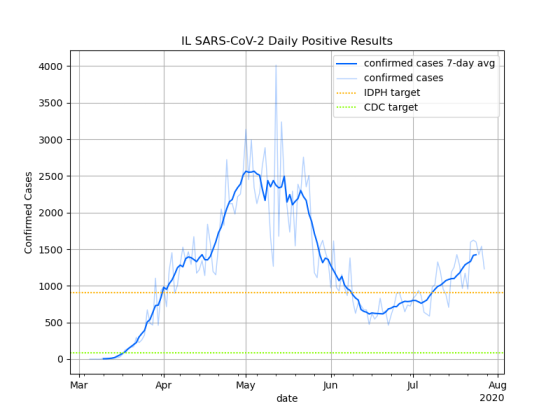
I’m no expert, but I’ve been poring over statistics on the Covid-19 pandemic since it began, and regularly tweeting out the numbers for the local Chicago area, and I’m starting to feel like I might have an understanding of some of the basics. And what I’m seeing right now has me worried that Illinois is headed for trouble.
Let’s start with the number of new confirmed cases per day in Illinois, which has been creeping up slowly for over a month. The 7-day moving average of 1442 new cases per day is 800 cases/day above the mid-June low point, and exceeds the Illinois Department of Public Health’s self-defined target (50 cases/week per 100,000 residents) by about 500 cases/day.
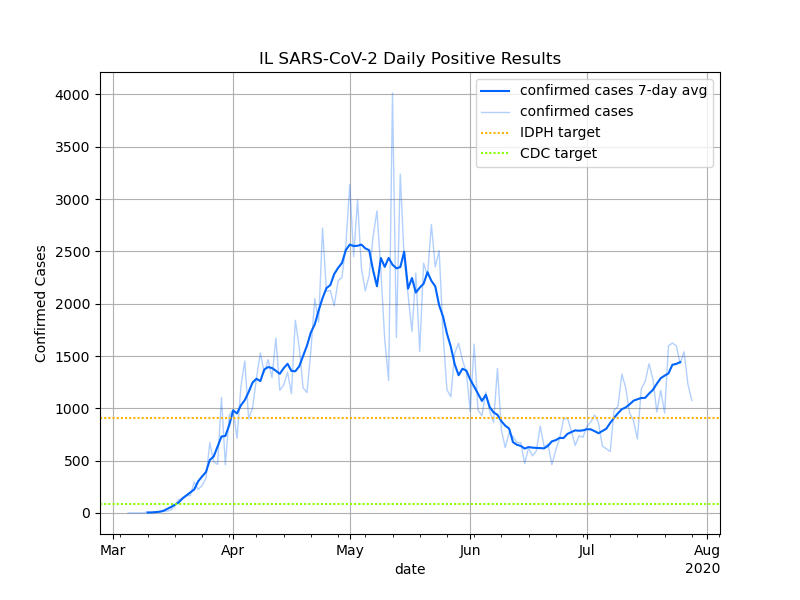
Some of that increase is probably due to increased testing volume over the past month and a half: The harder you look for Covid-19 the more of it you find, and Illinois has been looking pretty hard:
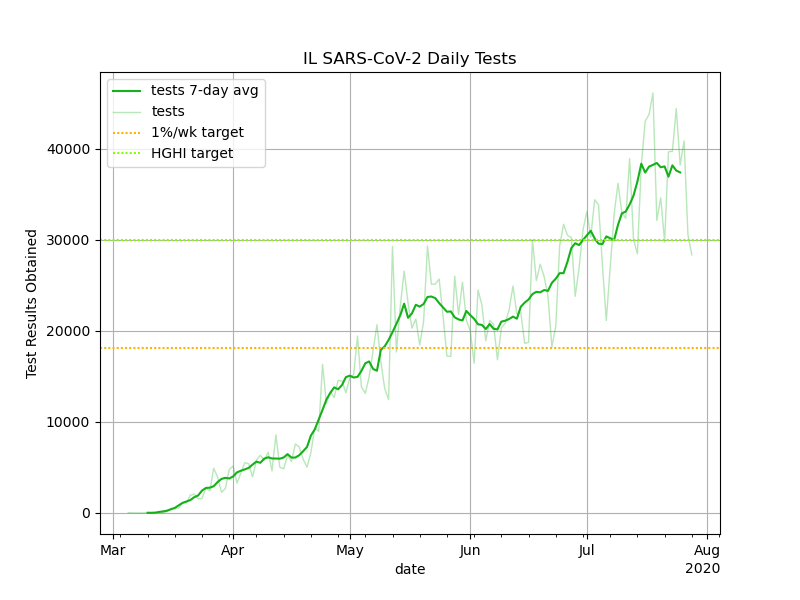
Note, however, that testing has stalled for the last 10 days or so, probably due to the high national demand, and yet the count of new confirmed cases has continued to rise. We’ve also seen a slight increase in test positivity, which would be unlikely if the increase in positive test results was solely due to the increase in testing volume:
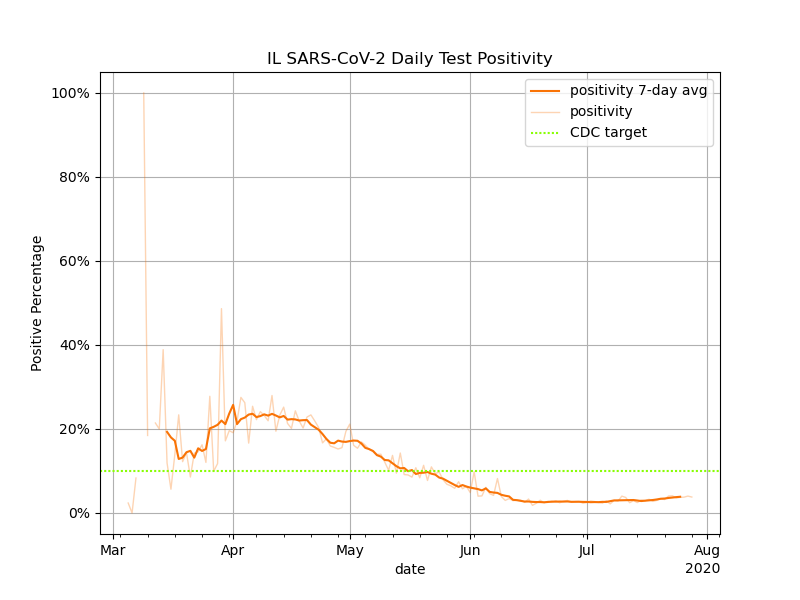
By now we’ve all seen the 3-stage pattern to a Covid-19 spike: (1) More cases, (2) more hospitalizations, and (3) more deaths. We seem to have more cases, and when we look at the next stage, hospitalizations, the number of people admitted with a Covid-19 diagnosis has stopped declining and has begun a gentle rise over the last 30 days:
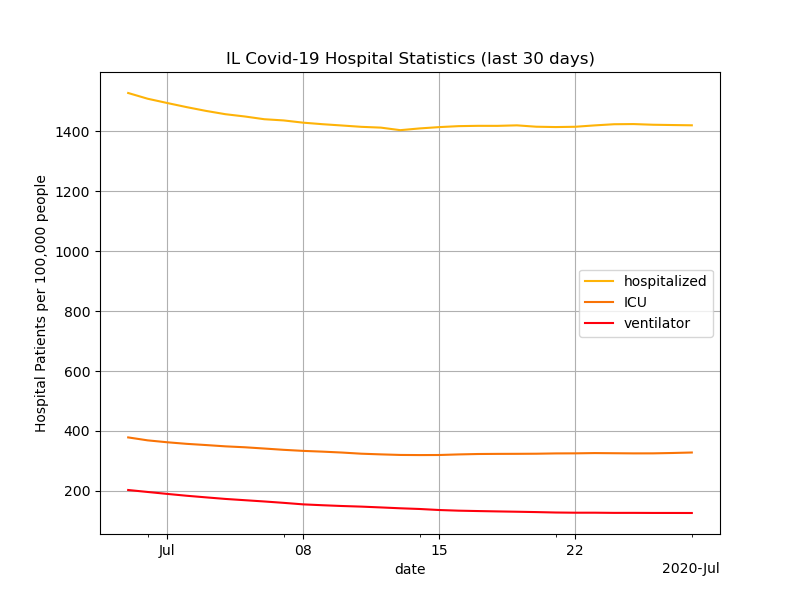
Checking the third stage, it looks like there might be an uptick there as well, with 30 deaths reported on Tuesday, the highest number in several weeks.
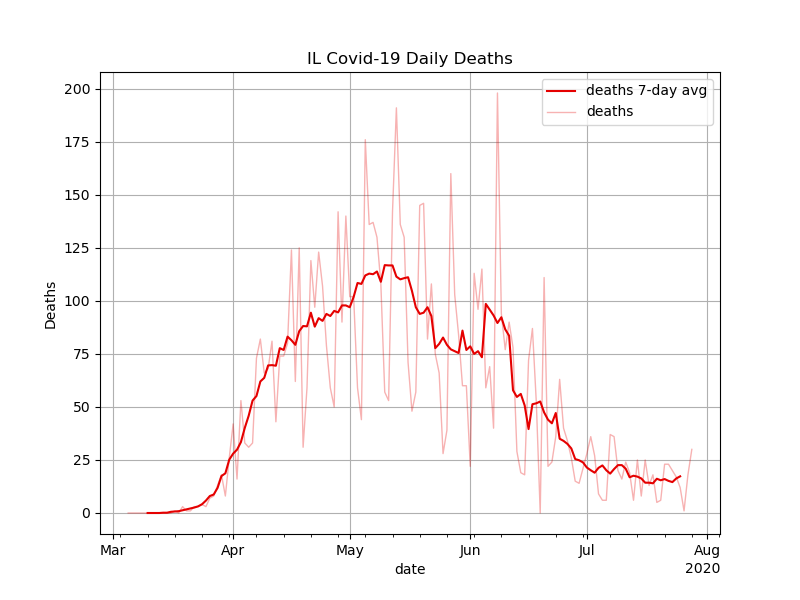
On the face of it, these statistics are not too alarming. But what worries me is the lag: From the time someone is infected with the Covid-19 virus until they realize they need to get tested is about 2 weeks. And with the large outbreaks in several states, testing facilities have been shipping nasal swabs far and wide to any labs that can process them, so test results here in Illinois are probably delayed a few days. That means we’re only just now seeing the results of viral transmissions that happened as long ago as three weeks. Or to put it another way, we won’t know how rapidly Covid-19 is spreading in Illinois today until three weeks from now.
That damnable lag between infection and detection is what keeps tricking people with this virus. Over and over again, in every city and every nation, by the time there’s clear statistical proof of a spreading epidemic, Covid-19 has already had time to get much worse. So no matter what we do to stop it, no matter how hard we lock down our activities, we’ll still have to watch the results of the previous three weeks of inaction play out for the next three weeks. And because epidemics can have exponential growth, the initial takeoff can be frighteningly fast — during the last three weeks of March, the daily case count in Illinois grew more than 100-fold. And despite our efforts, if this is the beginning of a new wave, we will have no choice but to sit and watch helplessly, as more and more people test positive, check into hospitals, and die.
We had that experience once here in Illinois, and that was enough to make me damned sure we don’t want to have it again. I think that means we have to assume this increase in cases, positivity, hospitalizations, and deaths is a sign that something bad started happening three weeks ago, and has been continuing unabated until now. We just can’t see it yet, but I think it’s time to take action. I think it’s time for another lockdown.
The good news is, we don’t have to lock everything down. Not this time.
Over the past couple of months we’ve vastly increased our testing volume and stood up a contact tracing operation. Unfortunately, that’s all stalled out right now because of the backlog in testing — you can’t start contact tracing until you know which people are infected, and when it takes a week to find out, there’s really no point. However, during that remission in the epidemic, we learned a lot about how Covid-19 spreads, and we ought to be able to use that knowledge to execute a much more targeted shutdown, one that drastically slows the spread of the virus while allowing safer businesses to remain open, and safer social activities to continue.
I don’t know enough to know what that will look like. We know that Covid-19 is more likely to spread indoors, when large numbers of people are close together, for long periods of time, with lots of heavy breathing. That sounds like it’s probably going to rule out bars and large celebrations like weddings, as well as a variety of industrial and commercial activities, and probably some public transit. Hopefully public health officials can narrow it down a lot more than I can. Maybe we don’t need to close all bars, for example, just bars with certain arrangements of seating, or certain types of air conditioning.
It helps a lot that it’s summertime. Because if we’re going to take the economic hit of another lockdown, it’s better to do it now, when a lot of these activities can be moved outdoors instead of shutting down completely. Even just opening the windows might make a difference in some situations. We’ll be much better off if we do our best now to eradicate Covid-19 as much as possible. During May and June we manged to knock down our new case count from 2400/day to about 600/day, a 4-to-1 improvement. If we can do something like that again, and get the daily case load down to 150/day (half that would be even better) then we probably have the test-and-trace resources to open things up again and keep the new case rate under control through the winter.
I should conclude by reminding you that I’m definitely not an expert at this, but I’ve been reading and listening to experts, and from what I understand, I think we need to do this, I think we need to do this now, and I think we should be able to pull it off if we act quickly and decisively. (I’m looking at you, Governor Pritzker.)
Truthfully, it’s possible this is already underway. Much of the increase is probably accounted for by flare-ups in specific locations, and cities and counties have been tweaking the local reopening regulations on a regular basis. But since the lag delays good news as well as bad, it’s possible that effective changes have already been made that just aren’t showing up yet. Let’s hope so.
Update: Literally as I was writing this, the Governor of Illinois held a press conference where he announced that several regions had positivity values approaching the state’s 8% trigger mark for reverting back to stage 3 of the reopening plan, and a few counties had warnings indicating they might need to roll back soon. Then Dr. Ngozi Ezike (Department of Health Director) went over the latest statistics, during which she confirmed my observation of increased case and hospitalizations. (She did not mention an increase in deaths.) The Governor also announced that many (but not all) youth sports activities will be shut down due to observations of some Covid-19 clusters among players.
(The explanation of Illinois’ reopening plan, regions, stages, and metrics can all be found at the IDPH Covid-19 page.)
Leave a Reply